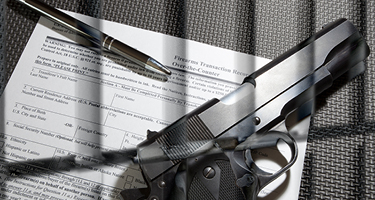Trial attorneys focused on preparing for trial may approach the document that will serve as the culmination of the trial – the verdict form – last, and with little thought. But that verdict form deserves close attention. Do not simply reach for uniform verdict forms and use them without thought. While those familiar uniform verdict forms are good places to start, they may not offer an approach favorable to the defense. For a variety of case-specific reasons, you may want a detailed verdict form, or a very general verdict form. You will also want to consider the “same nine” rule and how that rule might affect a verdict. This rule may offer those of us representing defendants further opportunities to obtain a defense verdict.
The “same nine” rule is derived from article VII (Amended), section 5(7) of the Oregon Constitution, which provides that, in civil cases, “three-fourths of the jury may render a verdict.” Where the jury consists of 12 members, that constitutional provision requires the same nine jurors to agree on every interdependent element of a particular claim against a particular defendant. In other words, the “same nine” rule applies where the answers reached by the jury are interdependent and build to a verdict for one of the parties. It does not apply in situations where the answers are separate and independent.
Currently, UCJI No. 90.03A, the special verdict form for “Fault/Negligence, Causation, and Damages,” and UCJI No. 90.04, the special verdict form for “Comparative Fault/Negligence,” begin with a preliminary instruction regarding the “same nine” rule: “At least the same nine jurors must agree to the answer for each of the following questions that you answer.” (Emphasis added.) UCJI Nos. 90.03A and 90.04 then pose the following separate questions for the jury regarding negligence and causation:
1. Was the defendant [at fault/negligent] in one or more of the ways the plaintiff claims?
ANSWER: (Yes or No)
If “yes,” go to question 2.
If “no,” your verdict is for the defendant. Do not answer any more questions. Your presiding juror must sign this verdict form.
2. Was the defendant’s [fault/negligence] a cause of damages to the plaintiff?
ANSWER: (Yes or No)
If “yes,” go to question 3.
If “no,” your verdict is for the defendant. Do not answer any more questions. Your presiding juror must sign this verdict form.
The problem with the foregoing instructions is that they do not take into account that, although questions of negligence and causation are interdependent questions when building toward a verdict for the plaintiff, those questions are independent questions for purposes of rendering a verdict for the defendant. It is axiomatic that a plaintiff must prove each required element of his or her claim to prevail, such as negligence, causation, and damages. When a plaintiff fails to prove any one element, however, the defendant will not be liable.
To illustrate the problem presented by the preliminary instruction in UCJI Nos. 90.03A and 90.04 concerning the “same nine” rule, consider the simple negligence case involving a single defendant, where the plaintiff presents ambiguous evidence of negligence and poor evidence that the defendant’s conduct caused any injury. Thus, causation is the best defense. The jury is then instructed under either of the foregoing uniform verdict forms.
Assume that the vote on the first question, negligence, is nine to three in favor of the plaintiff. Because the verdict form has instructed that “[a]t least the same nine jurors must agree to the answer for each of the following questions,” the nine jurors who voted in favor of plaintiff-and only those nine-proceed to the question of causation. Now, for the defendant to obtain a favorable verdict based on causation, all nine who answered “yes” to the question of negligence would have to answer “no” to the question of causation. Likewise, for the plaintiff to obtain a verdict, all nine who answered “yes” on the negligence question would have to agree. Under the instruction, the three jurors who voted “no” on the first question on negligence would not participate in answering the second question on causation. Under the instruction given, there is a hung jury if those nine who voted “yes” on negligence do not agree on causation.
But, what if six of the nine who voted “yes” on negligence would answer “no” on causation? And, further assume that the three jurors who voted “no” on negligence would also vote “no” on causation. In such a case, the defendant just missed an opportunity for a defense verdict, because there were nine jurors who would have voted “no” on causation. Because causation is independent of negligence for purposes of a defense verdict, any nine jurors who answered “no” on causation could have rendered a constitutionally valid verdict for the defendant. Thus, in this situation, the uniform instruction did a disservice to the defendant.
One way to avoid this problem would be to combine the elements of negligence and causation into a single question, such as, “Was the defendant negligent in one or more ways claimed by plaintiff that caused damage to plaintiff?” Prior uniform verdict forms posed the questions of negligence and causation that way.³ Another way to avoid the problem posed by this hypothetical would be to ask the causation question first. Then nine jurors would have answered “no” on the first question, and the case would end with a defense verdict. But this forces the parties to engage in gamesmanship in ordering the questions on the verdict form.
Perhaps a better way to avoid the problem posed by the above hypothetical is to keep the questions of negligence and causation separate, but to clearly instruct the jury which nine jurors must agree on each question to reach a valid verdict. By keeping the questions separate, the jury is presented with multiple opportunities to render a defense verdict, and is forced to distinctly consider each element necessary to reach a valid verdict for the plaintiff. To achieve this goal, the preliminary instruction regarding the “same nine” rule could be omitted from the verdict form, and the questions of negligence and causation might be presented as follows:
1. Was the defendant [at fault/negligent] in one or more of the ways the plaintiff claims?
ANSWER: (Yes or No)If any nine jurors answer “yes” to question 1, go to question 2.
If any nine jurors answer “no” to question 1, your verdict is for the defendant. Do not answer any more questions. Your presiding juror must sign this verdict form.
2. Was the defendant’s [fault/negligence] a cause of damages to the plaintiff?
ANSWER: (Yes or No)If at least nine of the same jurors who answered “yes” on question 1 answer “yes” to question 2,go to question 3.If any nine jurors answer “no” to question 2, your verdict is for the defendant. Do not answer any more questions. Your presiding juror must sign this verdict form.
Similar considerations regarding the application of the “same nine” rule should be given to questions concerning the fault of multiple defendants, the comparative fault of the plaintiff, and any other affirmative defenses raised by the defendant or defendants. Any one of those may be an independent basis for a defense verdict.
Do not fall into the habit of proposing a current uniform verdict form without giving your case some thought. Strive to give your client every available opportunity to win the case. Simply put, where a question is independent for purposes of a defense verdict and the agreement of any nine jurors will do, the verdict form should say so.
For sources and more information, follow the link below.
If you need experienced legal representation, use the Best Lawyers Find a Lawyer tool to connect with attorneys ready to guide you.
















